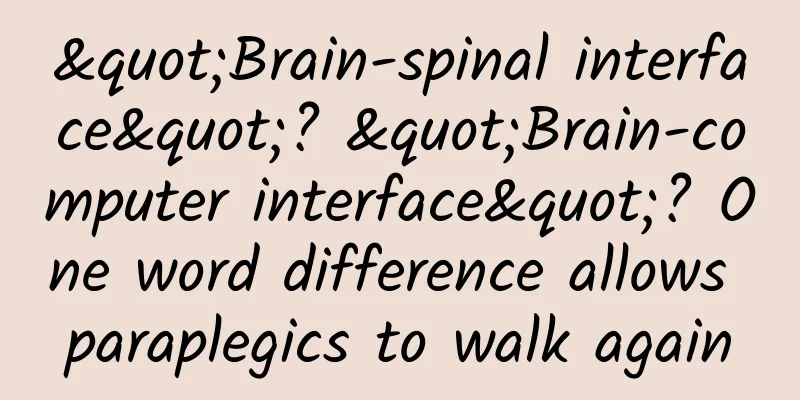"Brain-spinal interface"? "Brain-computer interface"? One word difference allows paraplegics to walk again

|
At the beginning of 2025, under the shadowless lamp of Zhongshan Hospital Affiliated to Fudan University in Shanghai, a miracle "neural bypass" operation rewrote the history of medicine. Two rice-sized electrode chips were implanted in the body of a 34-year-old patient named Xiaolin. His legs, which had been paralyzed for two years, "understood" the brain's commands, allowing him to "reborn" from the dead, even though he was originally judged to never be able to stand up. In the following three months, the research team of Fudan University completed three clinical concept verification surgeries using brain-spinal interface technology, all with remarkable results. Mainstream media such as CCTV Video and People's Daily reported this major breakthrough. Like a stone dropped into a calm lake, the results created a huge stir in the global medical community. So, what is brain-spinal interface technology? How is it different from brain-computer interface? Is this technology black technology or a medical revolution? 12 days after the operation, Xiao Lin is undergoing rehabilitation training under the guidance of the joint team (Photo from Fudan University official website) From "impossible" to "possible", the dilemma and breakthrough of paralysis treatment In the medical field, paralysis caused by spinal cord injury has always been regarded as an "incurable disease." When the spinal cord is interrupted by trauma or disease, the movement commands sent by the brain cannot be transmitted to the limbs, and the patient gradually loses control of the muscles and may even be trapped in a wheelchair forever. According to statistics, there are 3.74 million spinal cord injury patients in China, and about 90,000 new spinal cord injury patients are added each year. Many of them are young and middle-aged, and an accident completely changes their life trajectory. In simple terms, brain-spinal interface technology involves doctors implanting tiny electrodes in the brain and spinal cord. These electrodes can capture the "want to move" signals from the brain. Then, through a clever algorithm, the signals are translated into a "language" that the spinal cord can understand, and then transmitted to the spinal cord by electrical stimulation. This is like using a key to open the "lock" that controls the movement of the lower limbs, allowing the brain's instructions to bypass the damaged nerves and directly tell the lower limbs to "move," allowing paralyzed patients to regain the ability to walk. The key to this technology lies in accuracy and real-time performance. The brain's signals are like a complex ocean of electric waves, and brain-spinal interface technology needs to accurately capture specific waveforms representing movement intentions in this ocean. This requires not only high-precision electrode equipment, but also powerful artificial intelligence algorithms. The "three-in-one" brain-spinal interface technology pioneered by the research team of Fudan University is special in that it integrates three technologies, namely brain signal decoding, electrical stimulation optimization and neural pathway reconstruction, to form an efficient and accurate treatment system. The core lies in "stable, accurate and fast" - the lightweight AI algorithm model developed by the team, like a "super translator", can quickly convert the brain's motor commands (such as leg lifting and stepping) into electrical stimulation signals and transmit them to the spinal cord, ensuring that the patient's limbs respond quickly and accurately to avoid falls caused by delays. At the same time, the team uses a simulation computing platform to simulate human movement, screen effective electrical stimulation parameters in advance, skip invalid parameters, and allow patients to lift their legs on the day of surgery, greatly shortening the recovery time. Brain-spinal interface? Brain-computer interface? Don't confuse them "Are brain-spinal interface and brain-computer interface the same thing?" Many people have this question after the news of brain-spinal interface came out. In fact, although there is only "one word difference", there is an essential difference between the two. Although both brain-computer interface (BCI) and brain-spinal interface (BSI) are based on brain signals, their goals and paths are very different. Brain-computer interface is more like a "plug-in" for the brain. It focuses on the interaction of "brain→external device", allowing patients to control robotic arms, type and even play video games through their thoughts. Although this technology cleverly bypasses the limitations of the body, it cannot directly restore the patient's own motor function. In contrast, the brain-spinal interface is dedicated to the closed-loop reconstruction of "brain → spinal cord → body". It does not rely on external devices, but directly activates the body's own muscles through nerve signals. The goal is to allow patients to regain control of their legs and truly achieve "autonomous movement of the body". From a technical logic point of view, the brain-computer interface needs to convert brain signals into mechanical commands, such as converting "want to raise your hand" into "lift the robotic arm", which relies on complex algorithms and external hardware, as if opening a "detour" channel between the brain and the body. The brain-spinal interface is closer to "repairing the broken neural highway". It implants electrodes and sets up "signal transfer stations" above (brain) and below (spinal cord) the damaged spinal cord area, allowing brain commands to directly reach the nerves of the lower limbs and achieve natural walking, just like rebuilding a bridge on the damaged neural pathway. In terms of invasiveness and applicable population, brain-computer interfaces are both non-invasive (head-mounted devices) and invasive (implanted electrodes), and their functions tend to be "replacement" or "enhancement." Cerebrospinal interfaces must be implanted surgically, but their advantage is that they restore native functions and are more suitable for patients with incomplete spinal cord injuries and non-muscle atrophy. To sum it up in one sentence, the brain-computer interface is a "dialogue between humans and machines" that expands the boundaries of capabilities; the brain-spinal interface is a "dialogue between humans and their own bodies" that repairs life instincts. Will the two be combined in the future? Absolutely possible! For example, using BCI to control the exoskeleton to assist walking, while using BSI to activate one's own muscles to achieve dual rehabilitation. Xiaolin's first follow-up after surgery (Photo from Fudan University official website) From "signal transfer station" to "abandoning the raft and landing", the future of brain-spinal interface is promising Through a minimally invasive surgery of about 4 hours, when two electrode chips with a diameter of only about 1 mm were accurately implanted into Kobayashi's motor brain area and spinal cord epidural, a miracle of life was quietly taking place. On the first day after the operation, the right leg muscles that had been dormant for many years began to tremble slightly; on the third day, the brain's commands drove the synchronous movement of both lower limbs for the first time; on the tenth day, the patient was able to independently control the stride and walk of both lower limbs; on the 49th day, Xiaolin was able to walk independently using a walker under suspension - behind this series of seemingly incredible advances is the persistence of Chinese scientists over a decade, which has opened up a new track for the treatment of spinal cord injuries. Even more exciting is that the Fudan University team also observed the effect of brain-spinal interface on neural remodeling in the subjects - Xiaolin showed neural remodeling effects less than two weeks after the operation. "If the brain-spinal interface is implanted, coupled with three to five years of rehabilitation training, the patient's nerves are expected to be reconnected and reshaped, and eventually we may be able to get rid of the device instead of relying on it for life." The research members believe that "abandoning the raft and landing on the shore is the best brain-spinal interface technology." Further observation will help us understand the mechanism behind its remodeling. The future of brain-spinal interface may be long, but the future is promising. |
<<: Does exercising more before bed really help you sleep better?
>>: Hyperlipidemia: Is your blood too oily?
Recommend
Lab42: Love in social media
Dongxi.net Chinese version: //dongxi.net/b130w...
What is vaginal adhesion?
Vaginal adhesions can be divided into congenital ...
Benefits of Cervical Dilation Balloon
We all know that natural childbirth is the best w...
What causes changes in the menstrual cycle?
For many women, when there is a change in their m...
Can I have sex at 32 weeks of pregnancy?
There are many young pregnant women around us. Wh...
What are the benefits of vaginal reduction surgery?
Many female friends have loose and not firm vagin...
Drink Motherwort for less and darker menstrual flow
Irregular menstruation is a common gynecological ...
Does body temperature change significantly after IVF?
Nowadays, due to various reasons, the incidence o...
Will women's menstruation be irregular during menopause?
The stage in a woman's life when the physiolo...
Non-menstrual bleeding for more than ten days
If you have non-menstrual bleeding for more than ...
What are the symptoms of Trichomonas vaginitis
The incidence of vaginitis is increasing, and it ...
Beware! Don’t squeeze pimples! A man developed a hemangioma because of this…
Everyone loves beauty, but acne comes from time t...
Will urine protein be high during menstruation?
Women will have many different behaviors during m...
How to calculate the safe period after menstruation?
In our lives, for some young couples who have jus...
Will a decrease in estradiol lead to miscarriage?
The amount of estradiol at a certain level will a...









